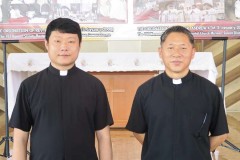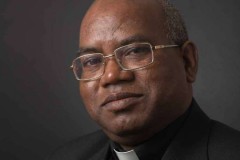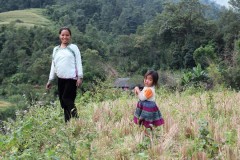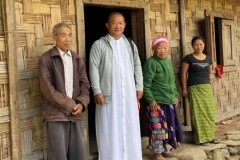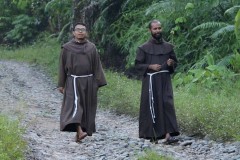
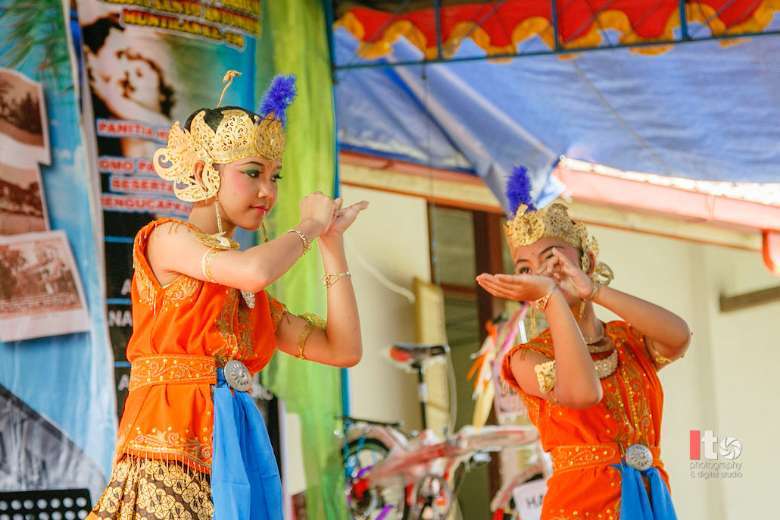
Two girls perform a Javanese traditional dance during an event to mark St. Anthony Church's anniversary in Muntilan on Java island. (Photo: St. Anthony Parish)
Jesuit Father Paulus Agung Wijayanto’s long-cherished dream to be a missionary was fulfilled when he was appointed to work in a historic parish on Indonesia’s Java island.
The 57-year-old Jesuit became the parish priest of St. Anthony Parish in Muntilan, Magelang district, three years ago. The parish was familiar to him because of its Muntilan Mission Museum, which he used to visit as a schoolboy.
“Since my ordination, I have worked in several parishes on Java and in Jakarta, but I always wanted to carry out missions where foreign missionaries have worked,” the priest said.
The Catholic faith arrived on Java more than a century ago. The church in Muntilan is considered as the birthplace of Catholicism on the island, gaining the local epithet Muntilan Bethlehem van Java (Muntilan is Bethlehem of Java).
Dutch Jesuit priest Father Franciscus Georgius Josephus van Lith began the mission in 1898. He baptized four locals in 1904, paving the way for Muntilan to become the springboard to evangelize and spread Catholicism across the whole of Java.
Muntilan is about 15 kilometers from Magelang Regency, a popular tourist destination famed for heritage Buddhist stupas and temples, such as the pyramidal Borobudur temple, and other archeologically important sites along with the beautiful Mount Sumbing, an active volcano.
Father Wijayanto takes care of the pastoral needs of some 3,000 Catholics in the Javanese Muslim-majority area with an estimated total population of 74,000.
“I like this mission and I want to strengthen the faith of the Catholics with spiritual values by preserving the cultural heritage the missionaries helped maintain so well,” Father Wijayanto said.
In the past 123 years, the parish has produced dozens of Indonesian priests, nuns and religious brothers to serve the Church on Java and in other parts of the country. Jesuit Cardinal Julius Darmaatmadja, retired archbishop of Semarang, is the most prominent among them.

Jesuit Father Paulus Agung Wijayanto, parish priest of St. Anthony Parish in Muntilan, Java. (Photo supplied)
“Local Catholics need to carry forward the great works of the missionaries to present the face of the Church in a pluralistic society,” Father Wijayanto said.
Muntilan is a largely agricultural region with plenty of rice fields and plantations. Traditionally, the locals have eked out a living as farmers, daily wagers, agricultural and plantation workers.
Interfaith relations are good in the parish’s multireligious territory, the priest said, referring to the spontaneous celebration of various religious festivals by all communities.
“This is a legacy of early missionaries who demonstrated how the Church can find a place among other faiths,” he noted.
Minority Catholics face challenges such as lack of education and jobs skills to become professionals, the priest noted.
The warm hug
Born in Semarang, the capital of Central Java province, Father Wijayanto grew up watching foreign missionaries who served parishes and made frequent pastoral visits to villages.
“They also met with and hugged children, often offering candies. I was one of those children,” he fondly recalled.
The missionaries also helped poor people to get on with their lives despite difficulties, which inspired the young child to follow in their footsteps one day.
As a student, Father Wijayanto developed a particular interest in the Church's history on Java. He started visiting the Mission Museum in Muntilan, about 100 kilometers from Semarang city.
His gradual exposure to historic and missionary church documents inspired him to choose a life of dedication and service to the people of God. The life and work of missionaries were inspiring, he said.

Jesuit Father Paulus Agung Wijayanto (Photo supplied)
In 1978, following high school graduation, he enrolled at St. Peter Canisius Minor Seminary in Magelang. By then he was exposed to the great works of Jesuits who pioneered evangelization on Java. In the seminary, some of his teachers were Jesuit missionaries.
He was ordained a priest in 1983 in Yogyakarta by Jesuit Cardinal Darmaatmadja.
“I found the missionary priests very interesting. They sacrificed their lives and taught values to people. Not only Catholics but also many other people admired and followed them,” Father Wijayanto said.
The young Jesuit prepared himself to go to any place, in any region, as a missionary.
“That is how, I thought, my childhood dream would be fulfilled,” he said.
The last Jesuit missionary
The paved, tree-lined road along the Progo River takes roughly one hour to reach Magelang city from Yogyakarta on Java island.
The 75-year-old German Father Siegfried Zahnweh, the last Jesuit missionary in Java, continues his mission as a psychological counselor at the Jesuit-run Girisonta Spirituality Center in Magelang.
The priest has spent more than two-thirds of his life on Java, the geographical and economic heartland of Indonesia.

German Jesuit Father Siegfried Zahnweh is one of the foreign Jesuits now serving Catholics in Central Java province. (Photo supplied)
For over 10 years, Father Zahnweh has offered spiritual and psychological counseling to mostly young Catholics under distress and couples seeking separation and divorce for various reasons. He is credited with reuniting hundreds of couples.
“I want to continue the works of the early missionaries in pastoral education and strengthen the faith of Catholics,” Father Zahnweh told UCA News.
At the center, the German missionary also conducts regular training courses for religious and laypeople to help them become promoters of justice and peace.
Colonial rule and Catholicism
Portuguese missionaries brought Christianity to Indonesia in the 16th century.
Among the most prominent missionaries was St. Francis Xavier, who evangelized in Ambon, Ternate and Morotai island in 1546-47.
Father Zahnweh is the last link in a long chain of missionary history in Java. He and three other German Jesuit seminarians arrived in 1961. It was shortly after Indonesia banned Dutch missionaries in 1960, presumably in retaliation for the 350 years of Dutch colonization of the country.
During the rule of the Vereenigde Oostindische Compagnie (VOC), better known as the Dutch East India Company, the Catholic Church was affiliated with the state — the clergy received their salary from the government and the state meddled in church appointments, records show.

A statue of Dutch Jesuit Father Franscicus Georgius Josephus Van Lith, who successfully spread the Catholic faith on Java. The statue stands in front of Muntilan Mission Museum, which showcases the history of the Church in the region. (Photo: Muntilan Mission Museum)
This led to disputes with the Dutch authorities and Catholic missionaries were expelled from the colony. Many Catholics were also forced to convert to Protestantism.
Indonesia’s Dutch ban became a blessing in disguise, prompting missionaries from other countries including Jesuits to flock to Indonesia.
Father Zahnweh and his friends were among the first generation of Jesuits in the newly independent nation. During their priestly formation in Yogyakarta, they also learned the Javanese language and culture, following in the footsteps of the early missionaries.
Ordained in 1966 in Yogyakarta, Father Zahnweh served as a parish priest in several parishes and taught in several schools in Semarang Archdiocese.
The priest said Catholics on Java can be justifiably proud of the great works of missionaries who put Catholicism on a strong footing by establishing high-quality schools, universities, and hospitals.
“The success of the missionary priests helped Catholicism grow and thrive in numbers on Java and encouraged other congregations from other countries to send their members,” he said.
Father Zahnweh said he loves to “fix the broken hearts” from across the country, suffering from economic hardships, impacts of social media and disharmony.
“It is my priority to help families so that they remain united and set examples to others,” he said.
Father Zahnweh is one of the founders of Civita Youth Camp, a pastoral center for young Catholics in Jakarta Archdiocese established in 1974.
Antonius Tri Usada Seno, a Catholic leader from St. Anthony Parish in Muntilan, appreciates foreign missionaries for their great contributions to the growth of the Church
“I am proud of the missionary legacy because, thanks to their struggles, the Catholic Church was able to play a vital role in our national life,” he told UCA News.
Foreign missionaries decline
On Java and in other parts of Indonesia, the number of foreign missionary priests has plummeted. Many have died and others have returned to their homeland due to advanced age.
There are some 20 foreign missionary priests on Java but all of them are over 70. Several congregations such as the Carmelites have no foreign members. There are four Jesuits on Java including Father Zahnweh.
The Franciscans, Vincentians, Holy Cross and Oblates, who together led the mission in Indonesia, have some 13 non-Indonesian members now.
However, local members have increased and even work outside Indonesia as missioners. For example, some 30 Indonesian Jesuits are now serving various countries as missionaries.
Father Zahnweh said more local priests from religious orders and even diocesan priests now work as missionaries in Europe, the Americas and Africa.
From Java alone, more than 500 priests have served Catholic missions outside Indonesia, church officials estimate.
The rise of Catholicism on Java owes much to two Dutch Jesuit priests, Fathers Josephus van Lith and Petrus Hoevenaars, who arrived in Batavia (now Jakarta) with backing from the Dutch government and the Vatican.
They landed in Central Java in 1897 to replace Jesuit priests F. Voogel and Hebrans, who had little success in evangelization.
They built St. Anthony Church in Muntilan, the first church on the island, in 1898. Both priests baptized some local people as they studied Javanese culture, language and arts including gamelan, traditional Javanese music.

St. Anthony Church in Muntilan, Central Java. The first four Javanese people were baptized as Catholics at the church by Jesuit Father Franscicus Georgius Josephus Van Lith in 1904. (Photo: St. Anthony Parish)
The first to be baptized were four villagers who came to Father van Lith to learn about Catholicism in 1904. Within seven months, Father van Lith baptized 171 villagers in a place that is now a popular pilgrimage site accommodating a cave shrine, holy spring and a religious complex with a large Marian statue.
Father van Lith’s success in evangelization was largely a result of his use of local language and culture, as he himself testified.
“Evangelization could touch the indigenous people, so we must be more accommodative with the local culture” and “Catholic theology has to unite with culture,” he once said.
The missionary also encouraged local Catholics to become priests. To make this vision come true, he built St. Peter Canisius Minor Seminary in Magelang. In 1926, three local men were ordained Jesuit priests, the seminary’s first fruits.
When the Apostolic Vicariate of Semarang was created in 1940, taking territories from the Apostolic Vicariate of Batavia (Jakarta), Father Soegijapranata became the first apostolic vicar and then first archbishop of Semarang, becoming the first indigenous bishop.
.jpg)
Our Lady's Shrine of Sendangsono in Central Java. The cave shrine is associated with a spring considered holy by Catholics. At least 171 people were baptized in the place in 1904, considered the second batch of baptisms on the island. (Photo: Muntilan Mission Museum)
Despite being Dutch, Father van Lith strongly supported Indonesian interests and opposed colonial authorities. His disciple, Archbishop Soegijapranata, continued his ideals and fought against Dutch and Japanese colonialists.
Father van Lith died in 1926 at the age of 62 and was buried at Muntilan. In 2004, the Church installed a giant statue of the great missionary in front of the museum at Muntilan to honor him and to preserve the history of the Catholic Church on Java island.
In 2008, the local government recognized the museum as a cultural heritage. “The buildings are always maintained well because of their extraordinary historical wealth and impact on educational history in Indonesia,” said Antonius Tri Usada Seno, head of the museum.
In the 20th century, several religious congregations started their missions on Java. With the rising Catholic population, the Vatican established more dioceses. Java now has two archdioceses and five dioceses.
From humble beginnings centuries ago, Java island today boasts more than 1.7 million Catholics.
Indonesia has some 8 million Catholics in 37 dioceses and archdioceses and one military ordinariate. Catholics make up some 3 percent of 267 million Indonesians. Protestants make up about 6 percent.
Rising from the ashes
The faith journey wasn’t always smooth or peaceful. During the Dutch VOC rule (1603-1779), all Catholic priests were expelled and the churches built by the Portuguese in Jakarta were turned into Protestant churches.
Catholicism resumed on Java with backing from the Vatican with the establishment of the Apostolic Prefecture of Batavia covering the whole of Indonesia in 1807. It would later become Jakarta Archdiocese.
“The mission was pioneered by diocesan priests from the Netherlands. So, historically, the Catholic Church mission was started by them,” said Father Simon Petrus Lili Tjahjadi, a lecturer in Catholic history at Driyarkara School of Philosophy in Jakarta.
Father Tjahjadi told UCA News that the persistence and loyalty of the missionaries laid the foundations for the pastoral, educational and health services of the Church on Java.
The priest also expressed gratitude to missionaries for teaching local people values such as vocation, sacrifice, bravery and humbleness.
The Church faced another bout of oppression in 1942 when the Japanese army occupied Indonesia during World War II and expelled all Dutch people including priests. Church facilities were confiscated and services remained closed until Japan’s surrender in 1945.

The interior of Sacred Heart of God of Jesus Church in Ganjuran in Yogyakarta, which is done in traditional Javanese style. (Photo: Sacred Heart of God of Jesus Church)
Even during this period of great danger and uncertainty, some brave missionaries, local priests and the faithful continued the Church’s services.
In Muntilan’s St. Anthony Church, Father Wijayanto, as the torchbearer of faith, is determined “to actualize” this mission and make it “relevant in public life concretely.”
“I always teach people to live up to the values of the missionaries, their sacrifice, diligence, love, and bravery,” he said.
The legacy of missionaries like Father van Lith continues on Java and other parts of Indonesia in churches, schools and hospitals, which not only benefit Javanese people but all Indonesians.
Besides education and health ministries, the Catholic Church on Java today has ventured into agriculture. Priests and religious teach farmers modern means of agriculture and stand by them for their lawful rights.
“Agricultural engagement is important. If the Church does not pay attention to this sector, it amounts to abandoning the roots,” the priest noted.
The biggest challenge, Father Wijayanto says, is the migration of young people to cities where they can find better education and employment opportunities.
“We need to do more work to develop rural, remote areas where mostly elderly people live now. We should find ways so that young people don’t abandon their roots,” he added.

